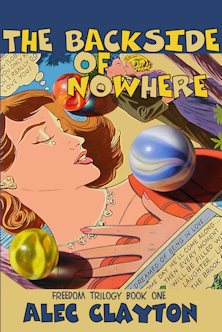
It takes me a year or two to write a novel, which means I spend that much time getting to know each of the characters in my novels. And then I forget about them. I go on to my next novel and a new set of characters, and tend to forget the earlier ones.
Literally. I forget them. For instance, someone once asked me if Lance in Imprudent Zeal was based on me. My thought was Lance? Who is Lance? I opened the book and skimmed enough to remind myself that Lance was the protagonist, the last character I should have forgotten. And yes, he was based on me as much as any of my characters are me or my friends or relatives. They are each an amalgam of me and people I have known— with a lot of imagination thrown in. I invent them, and they tell me who they are.
More recently, my friend Liz Latham, a musician, filmmaker and all-around cool gal, was working on an audio recording of part of my novel The Backside of Nowhere, the first book in the Freedom Trilogy. She called me because she found what she thought must be a typo—an obvious mix-up by which a girl named Lucy asks her mother if she can spend the night at Lucy’s house. Clearly from context, I meant to have her ask if she could spend the night at her friend Shelly’s house.
I didn’t recognize the character named Lucy even though I had invented her. I skimmed the book to find out that she was a minor character. I didn’t recognize her friend Shelly either, and she was a more important character—a girl who would grow up to be the protagonist’s mother.
I published that book fifteen years ago, and I have already forgotten not only two characters but practically the whole book. I do remember that the main character was named David, and he was a famous movie star who goes back to his hometown on the Mississippi Gulf Coast when his father is dying. I also remember that there’s a scene with a car plunging off an upper floor of a parking garage, another scene with a pair of teenage hoodlums looting businesses during a flood, and finally a scene with all the major characters being trapped in a house during a hurricane.
I found the typo and gave Liz the needed correction.
Since I had the book in hand, I read the back cover blurbs by the poet Larry Johnson and poet and novelist Jack Butler. My curiosity was piqued. I read the first two pages of the novel. Halfway through page two I muttered out loud, “Damn! This is good.”
The Backside of Nowhere did not start out to be the first book in a trilogy. Backing up a few years, here’s how it came about: We were driving through an industrial area south of Seattle, and I remarked to my wife that we were in “the backside of nowhere.” She said, “That should be the title of your next novel.” And so it was. I remembered a neighborhood in Biloxi, Mississippi called Back Bay, and decided a made-up town near there could easily be the backside of nowhere. I made up characters who lived there and based the plot on a hurricane, a common enough occurrence in that area.
Then, three years after publishing that one. I decided I should write a sequel. A lot of readers had been asking for it.
The town of Freedom in the previous novel had been wiped out by the hurricane but had been rebuilt. The teenage looters from The Backside of Nowhere, who appeared only in one brief scene in the first book, would now be grown men with families of their own. They are Sonny Staples, now an evangelical preacher with an eye for young women, and Malcolm Ashton, a grocery clerk with an alcoholic wife and three teenage children.
The new book was Return to Freedom, and after that one, I just had to do one more. The main characters in the final installment, called Visual Liberties, are Molly Ashton, an art student and daughter of Malcolm Ashton from the first two books, and Molly’s strange boyfriend Francis, who displays signs of autism but is never identified as autistic.
Ned Hayes, bestselling author of The Eagle Tree, called the book “a sweeping family drama and contemporary parable of art, love and meaning from America’s own bard of the Gulf Coast…”
All three books are still available on amazon.com, and I still enjoy bringing back to life characters from my earlier books, each of whom displays personality traits, patterns of speech and physical characteristics borrowed from friends and family and mixed with imagination; but none of whom are anyone other than themselves.

This was originally published here on May 30, 2024 on Alec Clayton – Writing, Etc.
Alec Clayton’s author page here on Mud Flat Press is here.

Hi Alec. It was fun to remember your characters with you. I haven’t read all these but now feel compelled to do so. I’d love to know more about your process for writing a novel. You seem to do it with such ease. And the ones I’ve read have colourful and complex characters. I can hear their voices in my head. I’d really like to return to working on a novel I started many years ago, but I don’t have a good method. Any advice?
Thanks for the comments, Don. I will reply via email. And BTW, you have been very helpful in your critiques.